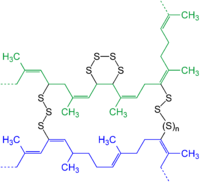
Photo from wikipedia
Antifogging and frost-resistant coatings can be used in a wide range of applications and enable high light transmission through substrates even under changes in environmental conditions. In this study, surface… Click to show full abstract
Antifogging and frost-resistant coatings can be used in a wide range of applications and enable high light transmission through substrates even under changes in environmental conditions. In this study, surface confined and cross-linked antifogging thin films are fabricated on glass slides via catalyst induced cross-linking (CIC), which has been recently introduced as an easy and efficient cross-linking methodology. Four different poly(ethylene glycol) (PEG)-based polymers with different hydrophilicity are synthesized and used to prepare films via CIC. Films prepared from the most hydrophilic PEG-based polymers display the best antifogging performances when exposed to a temperature change from −20 to 22 °C. Furthermore, several parameters including cross-linking density, surface roughness, hydrophobicity, and exposure time are also evaluated in terms of film transparency. Through these measurements, it is determined that, more loosely cross-linked films retain antifogging ability for longer time periods due to higher film swellability as compared to, more highly cross-linked films. This study signifies the crucial role of the film cross-linking density and hydrophilicity on the antifogging function.
Journal Title: Macromolecular Materials and Engineering
Year Published: 2017
Link to full text (if available)
Share on Social Media: Sign Up to like & get
recommendations!